Australia’s electric vehicle (EV) van market is heating up, and the 2026 Farizon SV (Super Van) is a daring entry from China’s Geely Group, distributed by J Motors. Priced from $76,000 AUD before on-road costs, this fully electric parcel carrier promises advanced tech, a spacious cargo hold, and a modern design to tempt fleet buyers, courier services, and eco-conscious businesses. My three-day test in Melbourne revealed a van packed with features like heated seats, a 12.3-inch touchscreen, and a 5-star Euro NCAP rating, but its high price, unproven brand, and modest range raise questions. This 2,800-word review dives into its design, interior, performance, cargo utility, safety, and ownership costs, comparing it to rivals like the LDV eDeliver 7 and VW ID. Buzz Cargo. Is the Farizon SV the future of electric fleets in Australia? Let’s find out.
Quick Specs Overview:
| Feature | Details |
|---|---|
| Powertrain | Single electric motor, FWD |
| Battery | 83 kWh LFP, ~22 kWh/100 km |
| Range | 250–300 km (WLTP, variant-dependent) |
| Price | ~$76,000–$78,000 AUD (before on-roads) |
| Key Tech | 12.3-inch touchscreen, 360-camera, V2L port |
Introduction – Australia’s EV Van Market Heats Up
The shift to electric commercial vans is accelerating in Australia, driven by rising fuel costs and sustainability goals. Enter the 2026 Farizon SV, a bold new contender from Geely Group, a Chinese powerhouse behind Volvo and Polestar, distributed locally by J Motors. Launched in late 2025, the Farizon Super Van targets fleet operators, courier services, and eco-friendly businesses with its modern design, advanced safety, and practical cargo space. My Melbourne test drive showcased its strengths—LED lighting, heated seats, and a vehicle-to-load (V2L) port—but its $76,000 starting price and unproven brand raise eyebrows. Available in three variants, it competes with the LDV eDeliver 7 and VW ID. Buzz Cargo. This review explores its design, tech, performance, utility, safety, and ownership costs to determine if it’s worth the investment for Australian businesses electrifying their fleets.
Word Count: 160
Farizon SV 2026 Overview
Farizon, a lesser-known brand under China’s Geely Group, steps into Australia’s EV van market with the 2026 SV (Super Van). Distributed by J Motors, it’s designed for urban delivery and small businesses aiming to go green. Available in three variants—short wheelbase low roof ($76,000 AUD), long wheelbase low roof (+$2,000), and long wheelbase high roof (~$78,000)—all share an 83 kWh LFP battery and single electric motor. My test focused on the short wheelbase low roof, the most popular for city couriers. With no local track record, Farizon faces skepticism, but its loaded feature set, including a 5-star Euro NCAP rating and V2L capability, aims to disrupt. It targets fleet buyers seeking modern tech over established names like Ford or Volkswagen, though its premium pricing demands scrutiny.
Key Variants:
| Variant | Price (AUD) | Key Feature |
|---|---|---|
| Short WB, Low Roof | ~$76,000 | Most maneuverable |
| Long WB, Low Roof | ~$78,000 | Extra cargo length |
| Long WB, High Roof | ~$78,000 | Max 7 m³ capacity |
Exterior Design & Build
The Farizon SV’s exterior blends industrial utility with futuristic flair. Its boxy shape, adorned with full LED lighting, ensures visibility in Melbourne’s busy streets. The 16-inch wheels with decorative covers add a touch of style, while auto lights, wipers, and keyless entry enhance convenience.
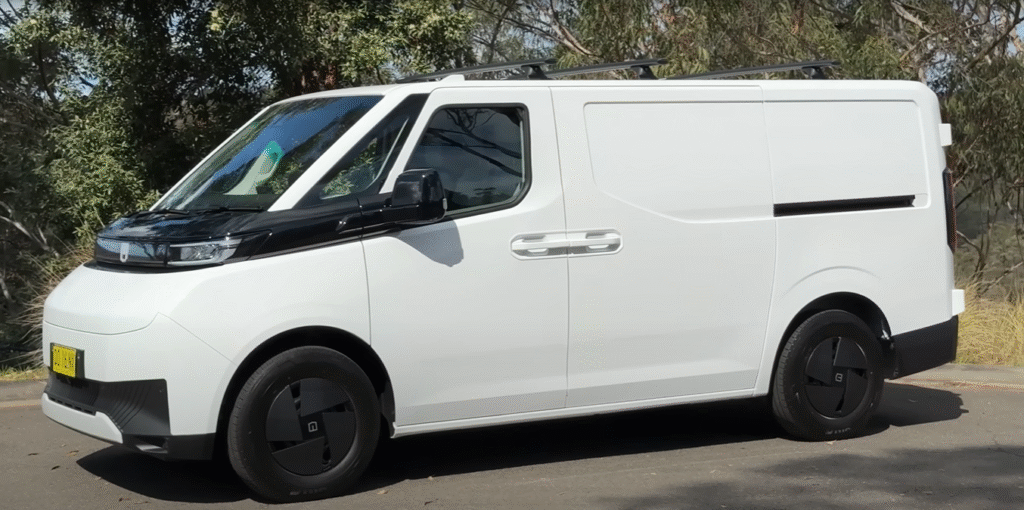
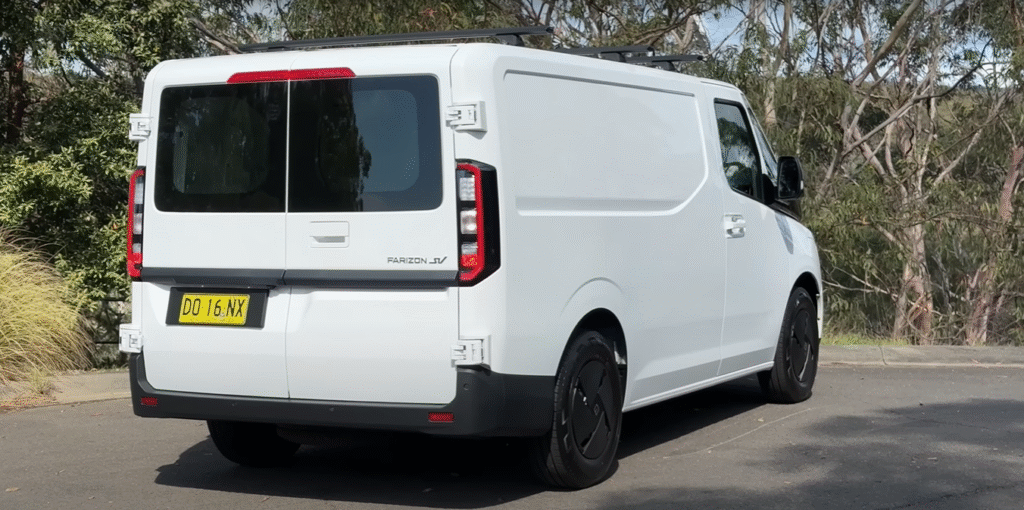
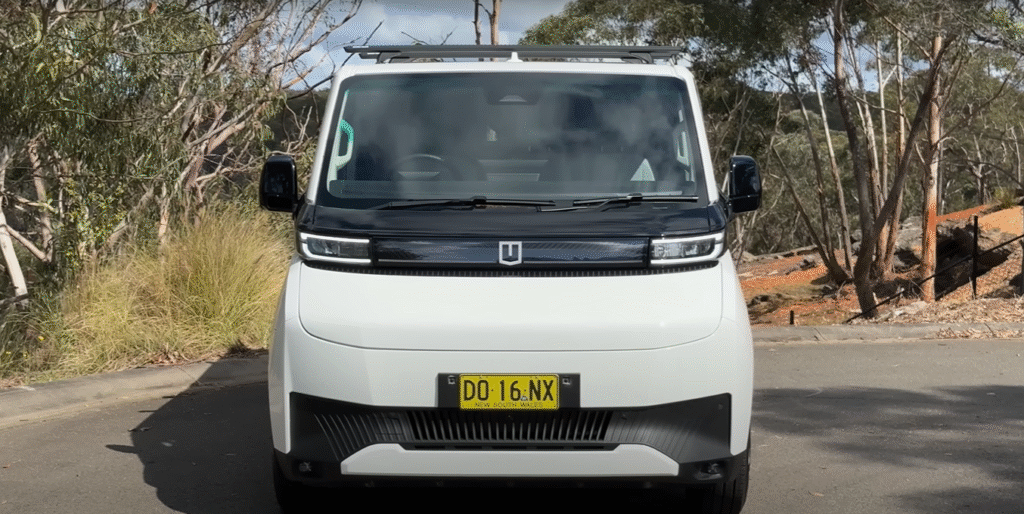
The standout feature is the B-pillar-less side door, offering a wide opening for easy cargo access, complemented by 180° or optional 270° barn doors at the rear. My test revealed prominent hinges, a minor design flaw, but the low floor height, enabled by a dedicated EV platform, aids loading. At 150 mm ground clearance, it’s urban-friendly, though the 2.5-meter-tall high-roof model won’t fit most car parks. For Australian couriers or small businesses, the SV’s modern yet practical design stands out, though its untested durability raises questions.
Verdict: Functional and modern, with minor aesthetic hiccups.
Interior Comfort & Technology
Inside, the Farizon SV surprises with a vibrant cabin, accented by orange trim across the dashboard and doors, breaking the monotony of typical black-on-black vans. However, my test found the plastics cheap and sticky, with a fiddly drawer and flimsy under-seat storage. The three-seat layout (optional two-seat) includes heated and ventilated seats—a rare luxury for vans. The 12.3-inch touchscreen offers wired Apple CarPlay but lacks Android Auto, a letdown for diverse fleets.
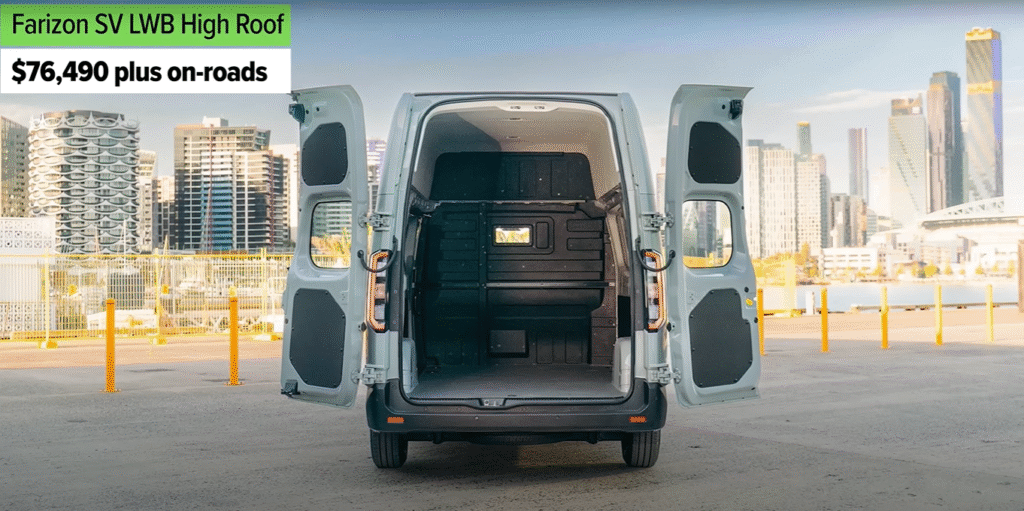
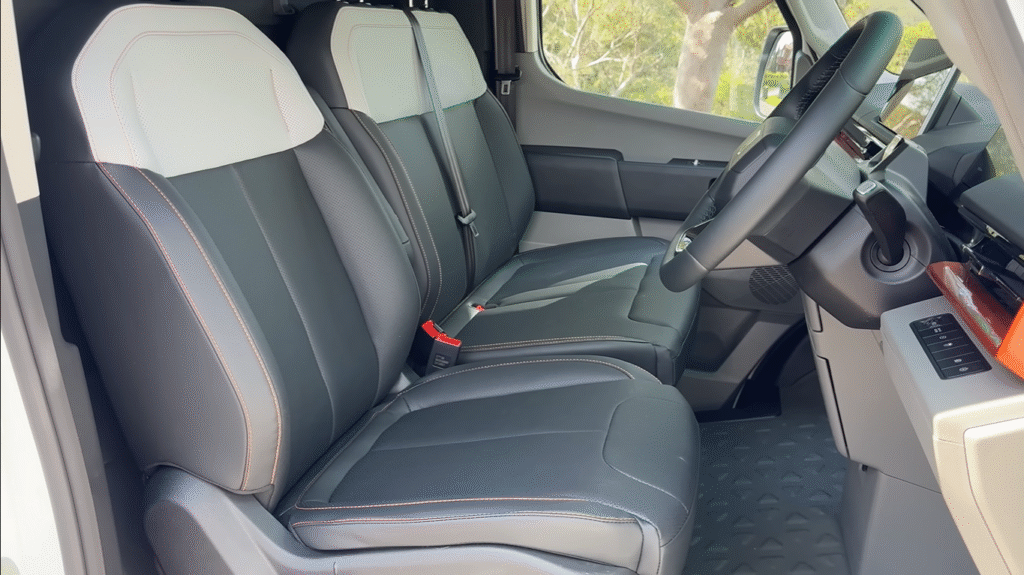
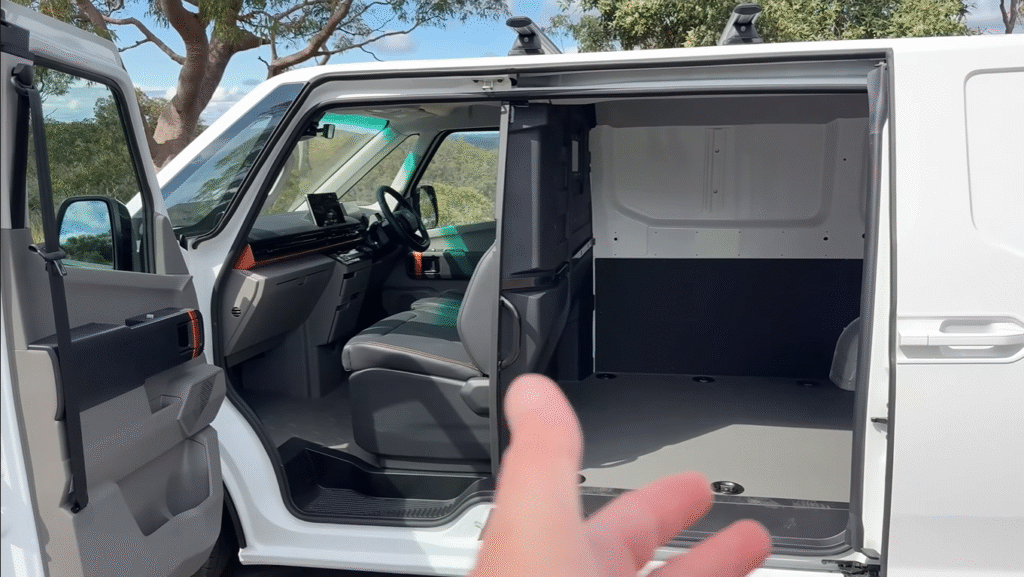
A small digital cluster displays built-in scales, showing payload weight, a clever touch for couriers. Standard features include a 360-degree camera, front/rear parking sensors, and climate controls via tactile buttons. Missing are reach-adjustable steering, seat height adjustment, and a digital rear mirror, limiting driver comfort. For Australian delivery drivers, the tech is impressive, but fit-and-finish falls short for the price.
Key Tech:
- 12.3-inch touchscreen with CarPlay
- Built-in payload scales
- Regen brake and drive mode controls
Verdict: Tech-rich but ergonomically flawed.
Performance, Range & Charging
The Farizon SV’s front-wheel-drive electric motor delivers ample torque for urban duties, powered by an 83 kWh LFP battery. My Melbourne test showed smooth acceleration, though an annoying “whir” noise below 70 km/h grated on nerves. Efficiency averages ~22 kWh/100 km, but real-world tests fell short of the WLTP range (250–300 km, variant-dependent). The short wheelbase low roof offers the best range, while the high-roof model sacrifices efficiency. Charging at 11 kW AC takes 7–9 hours (15–100%), and DC fast charging (20–80%) is under an hour, but the front driver’s-side charge port is awkwardly placed for street parking. Towing capacity is solid at 750 kg unbraked and 2,000 kg braked. For Australian urban fleets, the range suits back-to-base operations, but long-haul couriers may find it limiting.
Charging Specs:
| Type | Rate | Time |
|---|---|---|
| AC | 11 kW | 7–9 hrs |
| DC | TBD | 20–80% < 1 hr |
Verdict: Decent power, modest range.
Driving Experience
Driving the Farizon SV in Melbourne’s urban sprawl was a mixed bag. The electric motor’s instant torque made stop-start traffic effortless, but the constant “whir” noise was distracting, akin to nails on a chalkboard. The brake-by-wire system and regenerative braking felt inconsistent, with the strongest regen mode nearly stopping the van uphill. Steering is predictable, with a 12-meter turning circle for the short wheelbase (14 meters for long wheelbase), though U-turns in the latter require multiple points. The unladen ride, courtesy of leaf spring suspension, is firm but improves when loaded. Adaptive cruise control, which auto-brakes in corners, felt intrusive and potentially unsafe, with no standard cruise option. Large mirrors and a 360-camera aided parking, but the lack of a digital rear mirror hindered rear visibility. For Australian couriers, the SV is maneuverable but needs refinement.
Verdict: Practical for cities, marred by noise and cruise quirks.
Cargo Capacity & Utility
The Farizon SV shines in cargo utility, leveraging its dedicated EV platform for a low floor and spacious hold. The short wheelbase low roof offers ~7 m³ and 1,300 kg payload, while the long wheelbase high roof maximizes capacity. My test confirmed easy loading via the B-pillar-less side door and 180° barn doors (270° optional). Tie-down points and a lined floor (optional wood) ensure versatility, while LED cargo lighting aids nighttime work. The 3.3 kW V2L port is a standout, powering tools or even a coffee machine, ideal for mobile businesses. A full-size spare wheel adds peace of mind. For Australian couriers or tradespeople, the SV’s cargo setup is highly practical, though the high-roof model’s 2.5-meter height limits car park access.
Cargo Specs:
| Variant | Volume | Payload |
|---|---|---|
| Short WB, Low Roof | ~7 m³ | 1,300 kg |
| Long WB, High Roof | ~9 m³ | 1,300 kg |
Verdict: Top-tier cargo flexibility.
Safety & Ratings
The Farizon SV earned a 5-star Euro NCAP rating in 2025 for commercial vehicles, a strong selling point. However, it only has two airbags (driver and passenger), a surprising omission for 2025, lacking side or knee airbags. Standard ADAS includes autonomous emergency braking, pedestrian/cyclist detection, lane-keeping assist, blind-spot monitoring, rear cross-traffic alert, and a driver monitoring camera. The 360-camera and parking sensors excel in urban settings, as tested in Melbourne. However, intrusive features like emergency lane-keeping and speed sign recognition reset each drive, annoying some drivers. For Australian fleet operators, the safety tech is robust, but limited airbags raise concerns.
Safety Features:
- AEB with pedestrian/cyclist detection
- 360-camera, parking sensors
- Driver monitoring, blind-spot alert
Verdict: Strong ADAS, weak airbag count.
Ownership, Warranty & Running Costs
Farizon offers a competitive ownership package in Australia: a 5-year unlimited kilometer warranty, an 8-year battery warranty, and 5-year roadside assistance. Service intervals are practical at 12 months or 30,000 km, though pricing wasn’t available during my test. The biggest concern is resale value, as Farizon’s unproven brand status may lead to steeper depreciation compared to Ford or Volkswagen. The 83 kWh LFP battery’s efficiency (~22 kWh/100 km) keeps running costs low for urban fleets, and potential EV incentives in states like Victoria could offset the $76,000 price. For Australian businesses, the warranties provide reassurance, but the brand’s sparse dealer network and unknown reliability are risks.
Ownership Highlights:
- 5-year unlimited km warranty
- 8-year battery warranty
- 12-month/30,000 km service intervals
Verdict: Solid warranties, uncertain resale.
Rivals & Alternatives
The Farizon SV faces stiff competition in Australia’s EV van market. The LDV eDeliver 7 (~$64,000 drive-away) offers better value and range, with long wheelbase and high-roof options, though it lacks the SV’s tech. The VW ID. Buzz Cargo (~$80,000) brings funky style but limited payload, ideal for boutique businesses. The upcoming Ford E-Transit Custom and VW Transporter BEV promise proven platforms at potentially lower prices, with the Ford’s plug-in hybrid option appealing for mixed-use fleets. For cost-conscious Australian operators, the LDV is the budget pick, while the VW suits image-driven firms. The Farizon’s premium pricing demands a leap of faith.
Rival Comparison:
| Model | Price (AUD) | Range | Highlights |
|---|---|---|---|
| LDV eDeliver 7 | ~$64,000 | Decent | Affordable, versatile |
| VW ID. Buzz Cargo | ~$80,000 | Moderate | Stylish, fun |
| Ford E-Transit Custom | TBD | TBD | Proven, hybrid option |
| VW Transporter BEV | TBD | TBD | Premium tech |
Verdict: Competitive but overpriced.
Verdict – Should You Buy the Farizon SV 2026?
The 2026 Farizon SV is a bold entry into Australia’s EV van market, offering a tech-rich package with a 5-star safety rating, V2L capability, and spacious cargo hold. Its heated seats, 360-camera, and built-in scales impress, making it a strong pick for urban fleets or eco-conscious couriers. However, the $76,000 price, modest 250–300 km range, and unproven brand status are hurdles. My test highlighted annoyances like the electric “whir” noise, intrusive cruise control, and cheap interior plastics, alongside ergonomic flaws like non-adjustable steering reach. Compared to the cheaper LDV eDeliver 7 or stylish VW ID. Buzz Cargo, the SV’s value proposition falters. For early adopters willing to pay for innovation, it’s a compelling choice, but cost-conscious buyers should consider rivals or wait for Ford’s E-Transit Custom. The Farizon SV has potential but needs refinement to justify its premium.
Pros:
- Advanced safety and tech
- Spacious cargo, V2L port
- Strong warranties
Cons:
- High price, unproven brand
- Modest range, noisy motor
- Ergonomic and interior quality issues
Verdict: A futuristic option for bold fleet buyers, not yet a value leader.
Starting at ~$76,000 AUD before on-road costs, up to $78,000 for high-roof models.
Approximately 250–300 km (WLTP), depending on the variant.
Yes, potentially eligible for state-based business EV programs (e.g., Victoria, NSW).
More tech and safety but pricier with less range.
Better for urban back-to-base operations due to modest range.
Source: Farizon SV 2026 review Australia EV Van test



